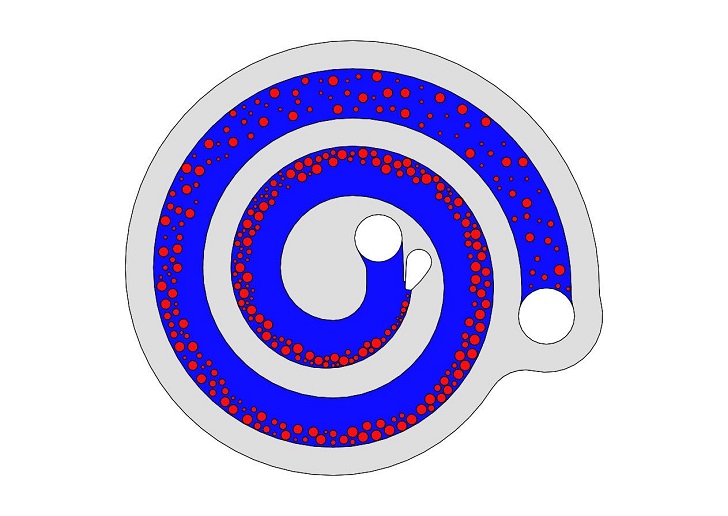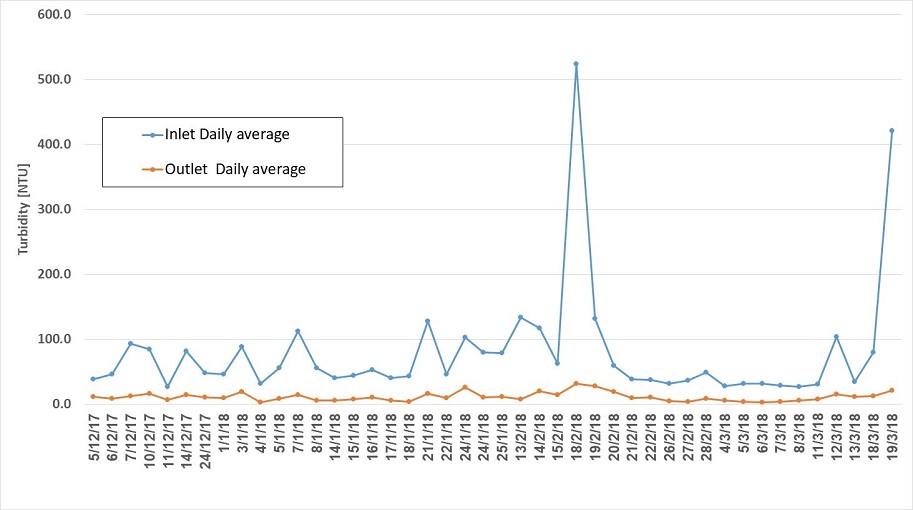

Methods that remove particles using centrifugal forces do exist as an alternative to separation density difference but are limited in the particle size. However, the hydrodynamic separator developed by AquaHD is free from the limitations of the conventional processes.
Surface water treatment facilities face the challenge of producing high quality clean water either for drinking, agricultural or industrial applications regardless of fluctuating turbidity and total suspended solids) (TSS) inlet conditions. To meet the increasing demand for high quality and continuous water supply, many water treatment plants will incorporate a solid separation step. This will be needed either as pre-treatment or a stand-alone process if turbidity levels exceed 50 - 100 NTU or for the treatment of fine particles (eg algae, silt etc.).
Traditionally, most solids separation processes are performed by separation that is dependent on the density difference between the water and the particles. Particles might have higher density than water and will settle in a settling basin or will have lower density than water, float and then skimmed from the surface of the water.
Since many particles have a density that is close to water, to achieve high efficiency of solids separation, separation by density difference to either work at very low velocity (0.5-1 m/hr), thus having large footprint and associated cost, or to invest high capital cost and use a large amount of energy to float the particles in Dissolved Air Flotation (DAF).
While process that removes particles using centrifugal forces do exist in the market as an alternative to separation density difference (eg Hydrocyclone), they are very limited in the particle size. Separation (larger than 70 um) and particles density (larger than 1.9 g/cc) and are used mainly for sand separation. The high shear forces created in the Hydroclyclone will prevent the use if coagulation and flocculation processes, since flocs will be broken making the process ineffective.
No limitations The recently developed hydrodynamic separator developed by AquaHD is free from the limitations of conventional solid separation processes. The hydrodynamic separator works by creating centripetal hydrodynamic forces to separate particles under low pressure (1bar). In the hydrodynamic separator, the water is flowing through a dedicated circular structure.
The pass of the water in the circular structure, allows the creation of high centrifugal forces (6-8 G) under low pressure. The unique geometry and flow patterns of the liquid inside the hydrodynamic separator, allows for the creation of laminar flow. The configuration of the separator was developed using a complex mathematical model that creates flow structure, causing high level and efficient separation of the suspended particles. Unlike other traditional solutions, hydrodynamic separator removes a wide range of organic and inorganic suspended solids as small as 2 micron, from water with dirt load of up to 4000 PPM of TSS.
Due to the high centrifugal forces, particles will be concentrated in the outer perimeter of the separator. Because of the laminar flow, particles stay in the outer perimeter layer and do not mix with the clean water in the inside of the separator. A specially designed outlet structure will separate the stream rich in particles (near the outer perimeter) and the clean water stream. Particles that have been removed from the water will either go a further sludge thickening and dewatering treatment or will be sent back to the environment (Figure 1).
Demonstration The performance of the hydrodynamic separator was tested and evaluated in a demonstration plant that simulated a facility for treating surface water with high turbidity. The demonstration plant was then challenged with the water of the Jordan River from December 2017 to March 2018 totalling 93 days in all.
The main goal of the test was to validate the capability of the hydrodynamic separator to achieve more than 70% removal of turbidity and TSS from the Jordan River. The second goal was to evaluate the performance of the hydrodynamic separator as a buffer to the significant turbidity fluctuations to enable the granular filter media to operate properly and without interruption. The project was done with the support of Mekorot, Israel Water Utility.
The turbidity of the river fluctuated significantly almost every day during the test period (Figure 2). Turbidity values increased from 40 NTU to 120-400 NTU, however they decreased back within a day or two. During this period, the turbidity of the hydrodynamic separator outlet water remained constant and most of the time was less than 20 NTU. Even when turbidity increased to 500 NTU, the outlet turbidity of the hydrodynamic separator increased only slightly to a value of 30 NTU. Figure 2 presents results from the separator achieved by the hydrodynamic separator
Success criteria Average turbidity removal performance of the hydrodynamic separator was above the success criteria (7 0% removal). The daily average turbidity removal (84.2%) and the average TSS removal (78.1%) both met and exceeded the success criteria described in the project's goals. It found that the higher the TSS, the higher the removal percentage. From 100 mg/l and up the removal percentage was 95%.
Operating two hydrodynamic separators in series achieved 90-95% turbidity removal versus 80-85% obtained by operating a single unit. The demonstration plant operated from December 2017 to March 2018, 93 days in all. The overall availability of the demonstration plant was more than 99%. The results clearly show that the hydrodynamic separator provides acceptable and reliable turbidity values. This makes it suitable for any surface water treatment application used for providing clean water with a quality that meets any client demands for either drinking water, industrial or agricultural needs.





